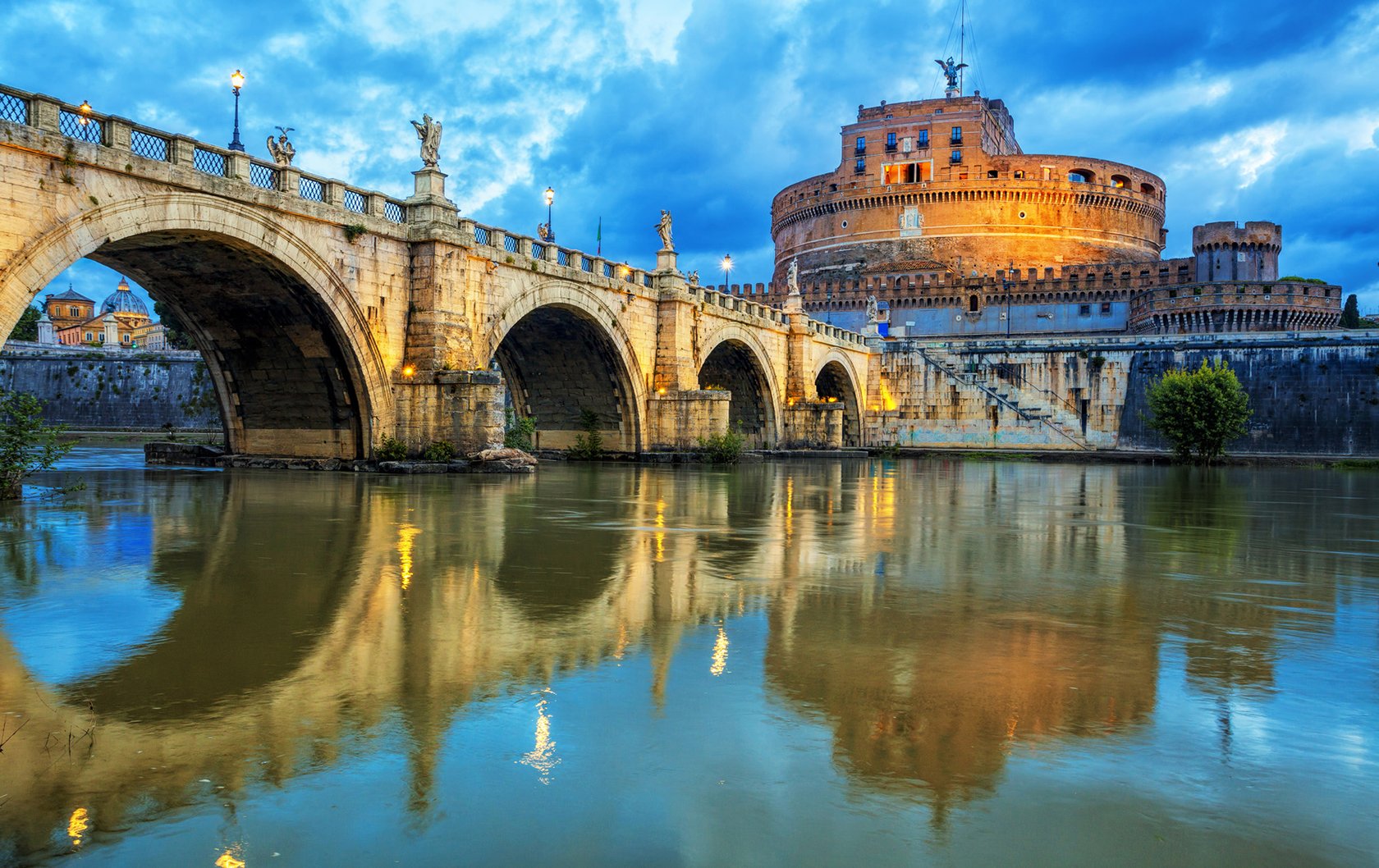
The gorgeous Ponte Sant’Angelo in Rome
Understanding the urban fabric of Rome means going back in time. In the case of the city’s beautiful bridges, that means starting at the very beginning of Rome. Like many ancient cities, Rome grew up on a river. The Tiber River runs right through the heart of the Eternal City, and it was here in the 8th century BC that Romulus and Remus, twin sons of the god Mars, were abandoned in a basket and left to drown. The twins were rescued by Tiberinus, the god of the Tiber River, and nursed by a she-wolf. Romulus founded Rome after the defeat and death of his brother.
Today that city Romulus founded has grown around the Tiber, which divides Rome with the ancient historic center to the east and Trastevere, Castel Sant’ Angelo and the Vatican City to the west. There are many bridges over the Tiber that you’ll crisscross while taking in the city’s top sights. Here are some of our favorite bridges in Rome that are as intriguing historically as they are beautiful to admire.
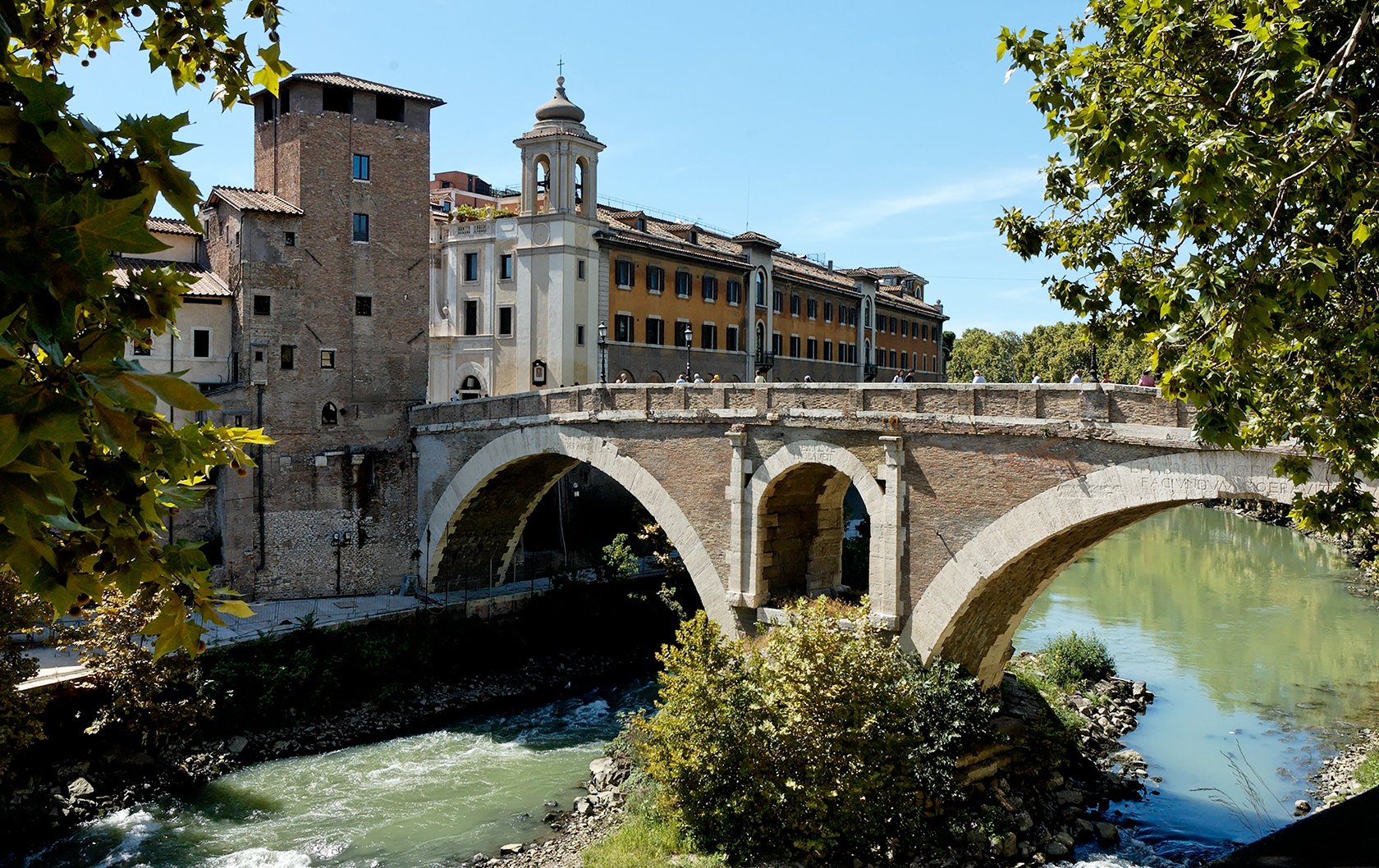
Ponte Fabrizio – Rome’s oldest bridge
Isola Tiberina and the Oldest Bridges in Rome
There’s no better place to start an exploration of Rome’s bridges than at the Isola Tiberina, the island in the Tiber located between the ancient center of the city and Trastevere. Here’s where you’ll find Ponte Fabrizio, which was constructed in 62 BC. Incredible to imagine! That date makes it the oldest bridge not only in Rome but also the world that is still in its original state and in continuous use. The Romans were well known for their bridge building skills, and it’s a remarkable experience to walk over this piece of Roman history. Just take a moment while there to stop and reflect on how much has happened right in this spot in over two thousand years.
While on the Isola Tiberina, walk south to the scenic spot at the tip where you can see one remaining arch of another bridge. This is the last piece of Rome’s oldest bridge, called the Ponte Rotto (Broken Bridge) or the Ponte Emilio, which originally spanned the entire Tiber. Built in the 2nd century BC, the bridge must have been a glorious sight in its day. Over the centuries, it was damaged many times by floods and was eventually partially demolished to make room for the Ponte Palatino, a 19th-century bridge nearby. One of the treasures of Rome is how these pieces of the ancient city are a part of the city’s landscape today. While in the area, read more about where to find a traditional Roman meal on the Isola Tiberina.
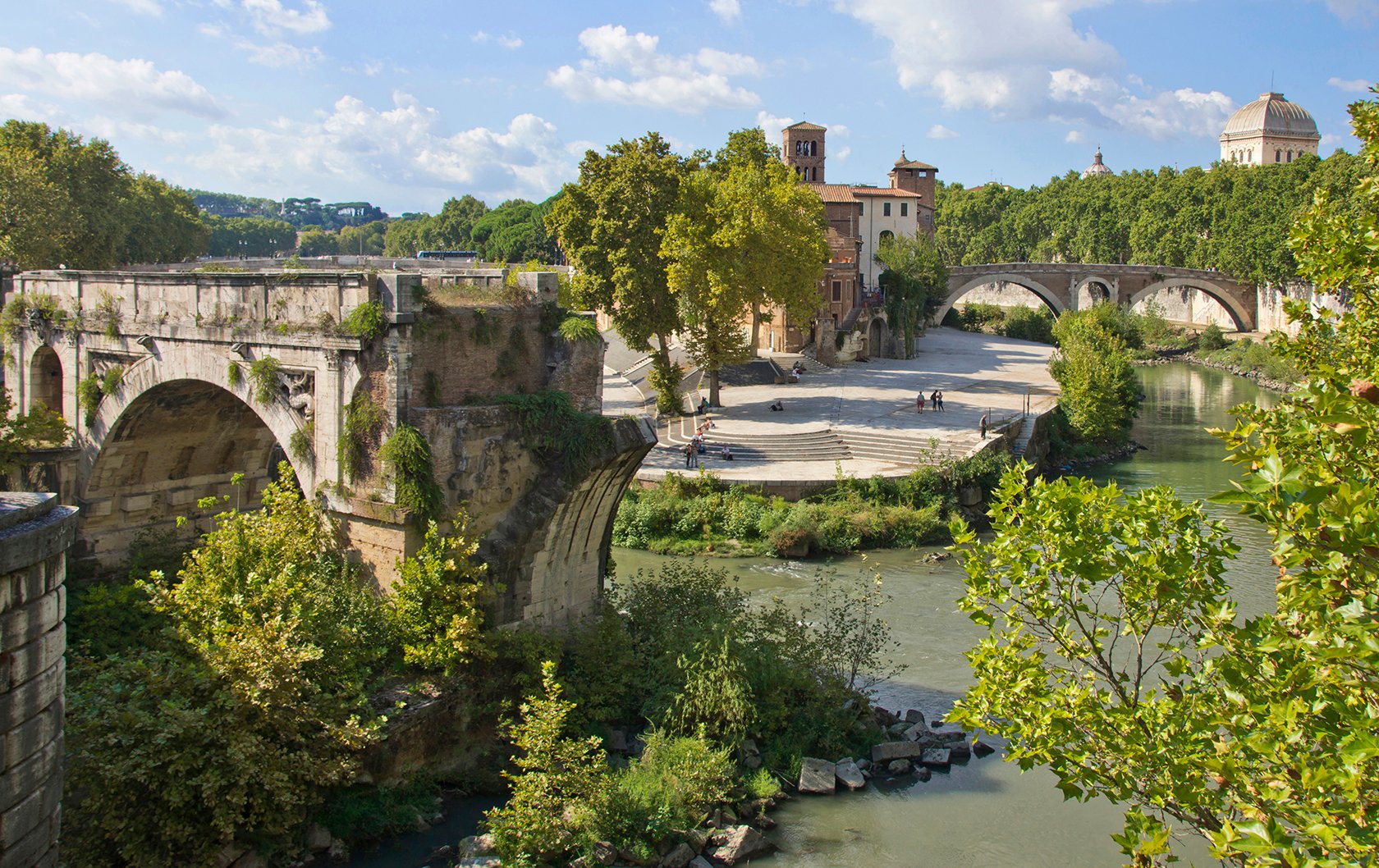
The Ponte Rotto – or Broken Bridge – in Rome (credit)
On the west side of the Isola Tiberina, the Ponte Cestio is a particularly photogenic bridge that is a modern reconstruction of a Roman bridge built shortly after the Ponte Fabrizio on the other side of the island. In the 19th-century, the bridge needed to be reconstructed and lengthened, and as a consequence only about one third of the bridge is made with pre-modern material. Yet, having been built on the same location, it gives the sense of how the Tiber island was connected to ancient Rome. This is the perfect spot to head off on an visit to the charming Trastevere neighorbood. Check out our guide for what to see and do in Trastevere for more tips! Enjoy a stay at our Cavaliere vacation rental and you’ll find Ponte Fabrizio and Isola Tiberina nearby.
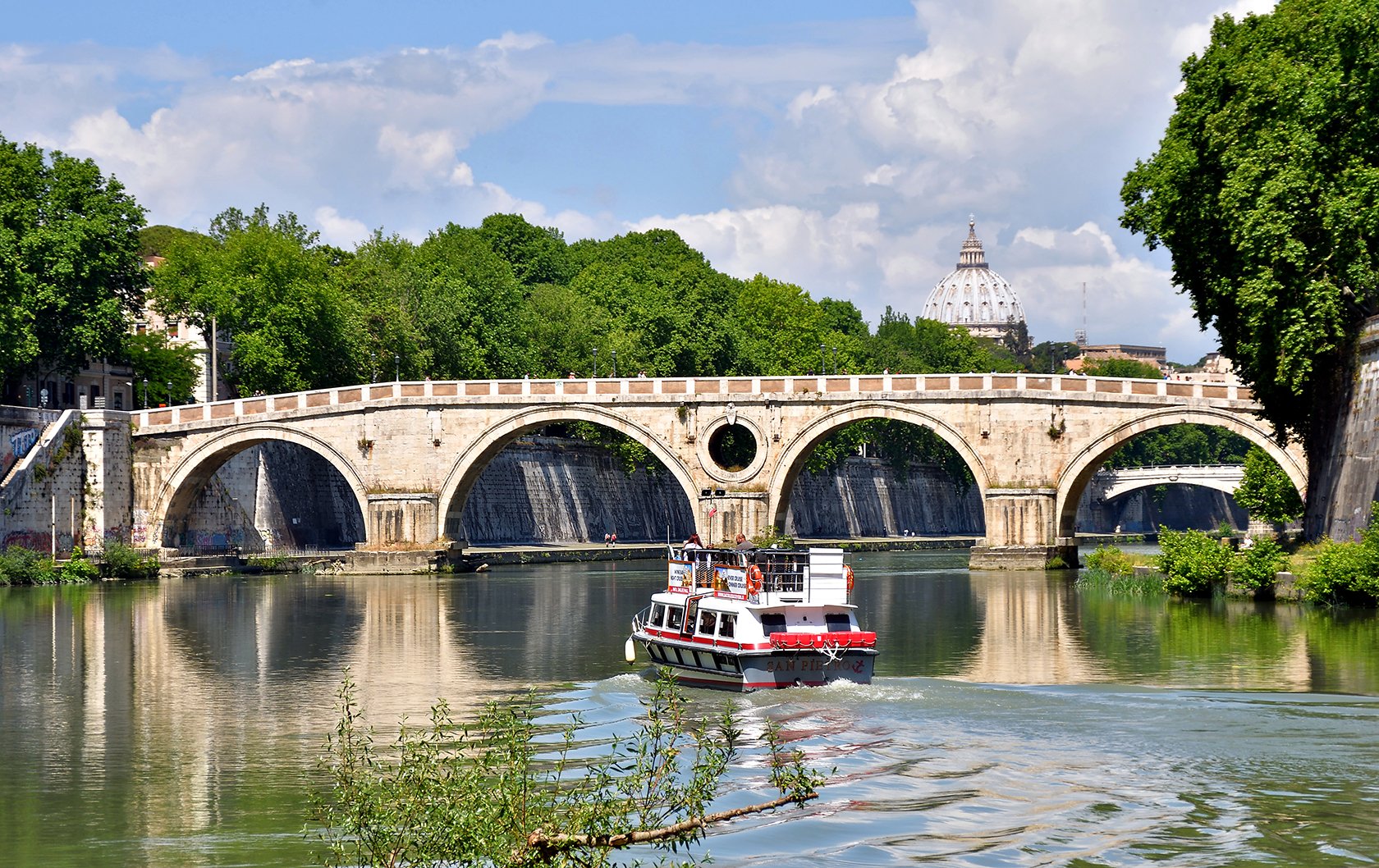
Ponte Sisto with the dome of St. Peter’s Basilica (credit)
Ponte Sisto
Not far from the Isola Tiberina, the Ponte Sisto crosses the Tiber connecting Piazza Trilussa in Trastevere to the Regola neighborhood in Rome not far from Campo de’ Fiori. This bridge was built from 1473 to 1479 on the site of an ancient Roman bridge. It’s named after Pope Sixtus IV, who commissioned it, and features four arches and a distinctive hole in the central pylon of the bridge. As Rome’s bridges have long been damaged by occasional flooding, this “oculus” was added to decrease water pressure during floods. Today Ponte Sisto is a cobblestoned footbridge and it’s a pleasant spot to stroll. From the eastern side of the bridge, you’ll have a view of the massive dome of St. Peter’s Basilica in the distance. A stay at our charming Pasquino apartment puts you only a short stroll from many of Rome’s beautiful bridges, including Ponte Sisto.
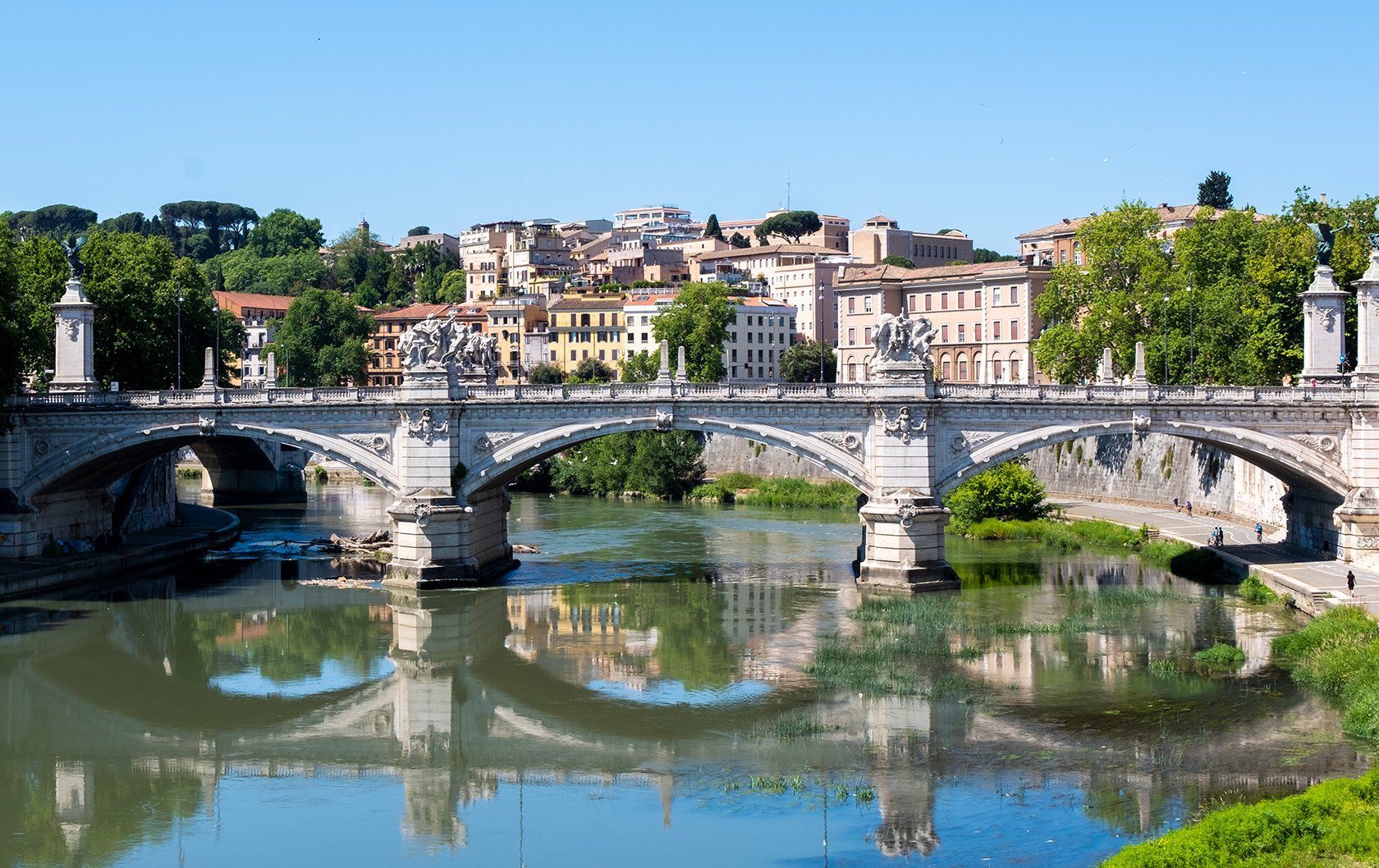
The elegant Ponte Vittorio Emanuele II (credit)
Ponte Vittorio Emanuele II
Continuing north, the Ponte Vittorio Emanuele II is Rome’s most stately bridge and is the main bridge leading to Via della Conciliazione, which connects Piazza San Pietro, the stunning piazza in front of St. Peter’s Basilica, to Castel Sant’Angelo. Ponte Vittorio Emanuele II is the continuation of Corso Vittorio Emanuele, the grand east-west road through Rome that starts at Piazza Venezia at the Monument to Vittorio Emanuele II. Just who was this Vittorio Emanuele II? He was the first King of Italy, that is, the first king of a united Italy after the unification in 1861. Construction on this bridge began in 1886, but due to delays wasn’t completed until 1911, just in time for the 50th anniversary of the unification of Italy.
The bridge is decorated at each end with four massive bronze statues of winged Victories. Along the bridge are four large travertine sculptural groups depicting allegorical scenes dedicated to key moments leading to the unification. This is a particularly scenic spot to enjoy a view of the Pont Sant’Angelo and Castel Sant’Angelo nearby.
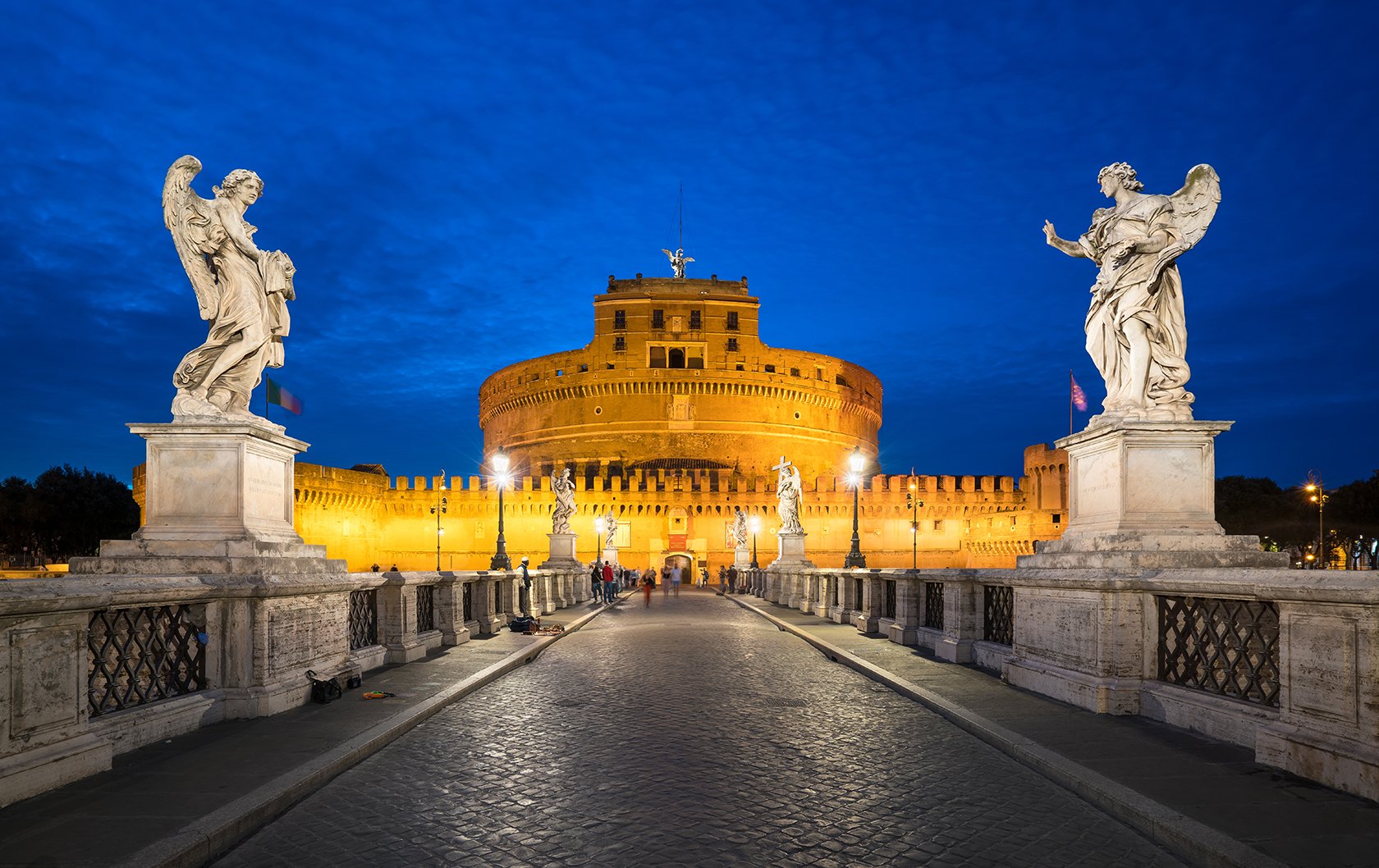
Walking along the Ponte Sant’Angelo (credit)
Ponte Sant’Angelo
Certainly Rome’s most impressive bridge, Ponte Sant’Angelo is also one of the city’s oldest bridges – at least in part. The bridge was originally constructed in 134 AD by the Emperor Hadrian to connect the city to his mausoleum, which is now the Castel Sant’Angelo. Three of the five arches of the bridge we see today are from the ancient Roman construction. The bridge is covered in Travertine and in the 16th century two statues of Saint Peter and Saint Paul were added on either side of the entrance to the bridge near Castel Sant’Angelo.
In 1669, Pope Clement IX commissioned a series of 10 statues of angels holding instruments of the Passion of Christ. These impressively sized statues have given the bridge its nickname as the Bridge of Angels. The first two to be designed were created by the Baroque architect Bernini and were among his last works. His statues were considered so beautiful that Pope Clement IX kept them for his private collection and they’re now found in Sant’Andrea delle Fratte, a very nice church near the Spanish Steps. The Bernini designed statues on the bridge are copies of the original. The rest of the angel statues were created by many of Bernini’s talented students. Now Ponte Sant’Angelo is a pedestrian only bridge, which is ideal for viewing the statues and surrounding Roman landscape. It’s stunning from every angle! Our Viola apartment is only a short walk from Pont Sant’Angelo, so you can admire the bridge during the day and also lit up at night.
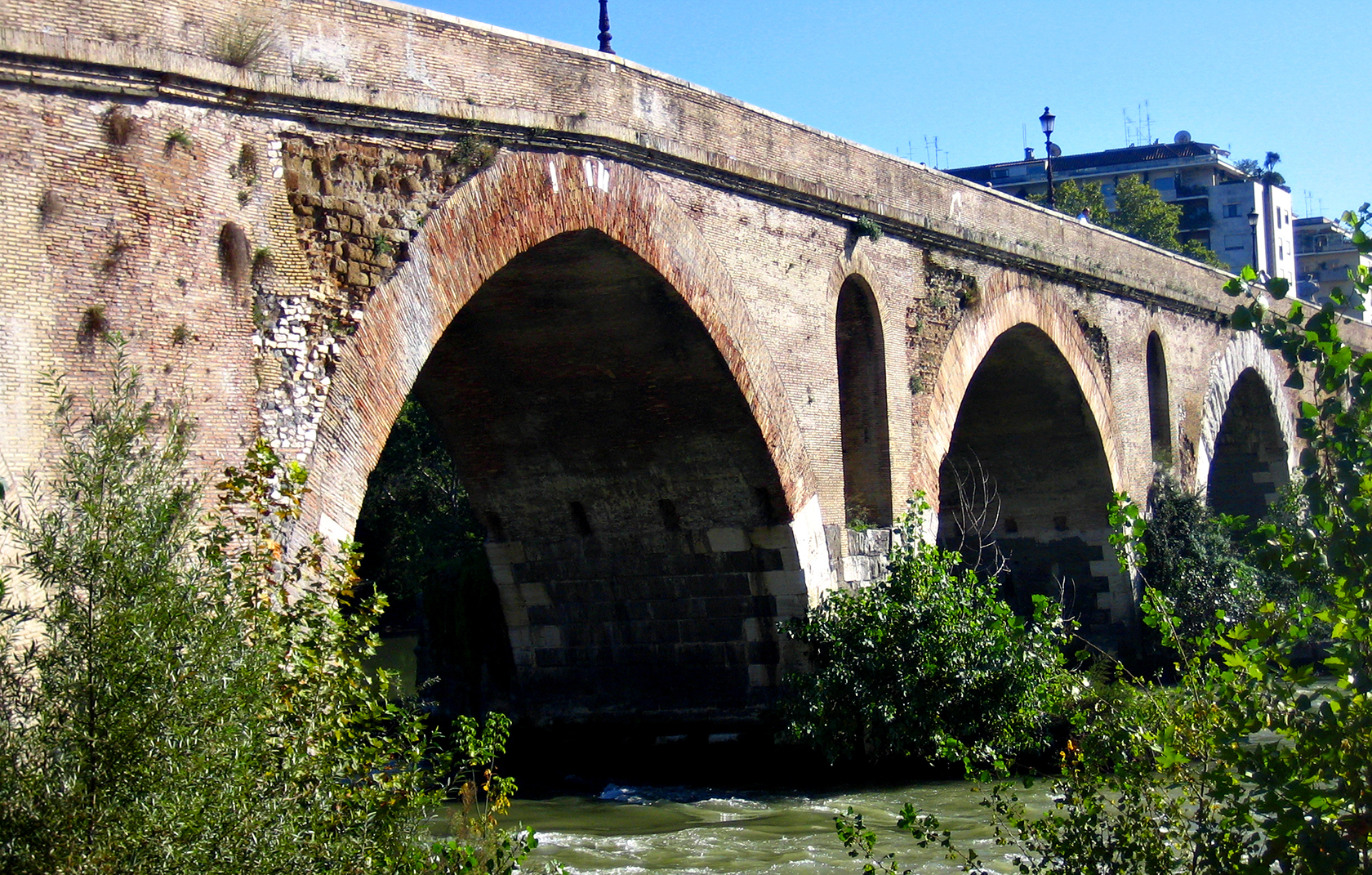
The historic Ponte Milvio bridge (credit)
Ponte Milvio
The Ponte Milvio in northern Rome is further out from the historic center. Yet due to its strategic location and important history, it’s one of Rome’s most intriguing bridges for history enthusiasts. The first bridge was built in this site in 206 BC and was later rebuilt in 109 BC on the same location. Here was the site of the violent Battle of the Milvian Bridge in 312 when the Roman Emperors Constantine I and Maxentius fought for control of the Roman Empire. In the end, Constantine I was victorious and became the sole ruler of the Roman Empire.
For Italy Perfect founders, Lisa and Pat, this bridge has fond memories from their time growing up in Rome. As kids, they would wait for the bus at the Ponte Milvio bridge and also remember the excellent supplì at a nearby café. These are the moments where the history of Rome–that is so much of part of the city today–becomes woven into the fabric of daily life.
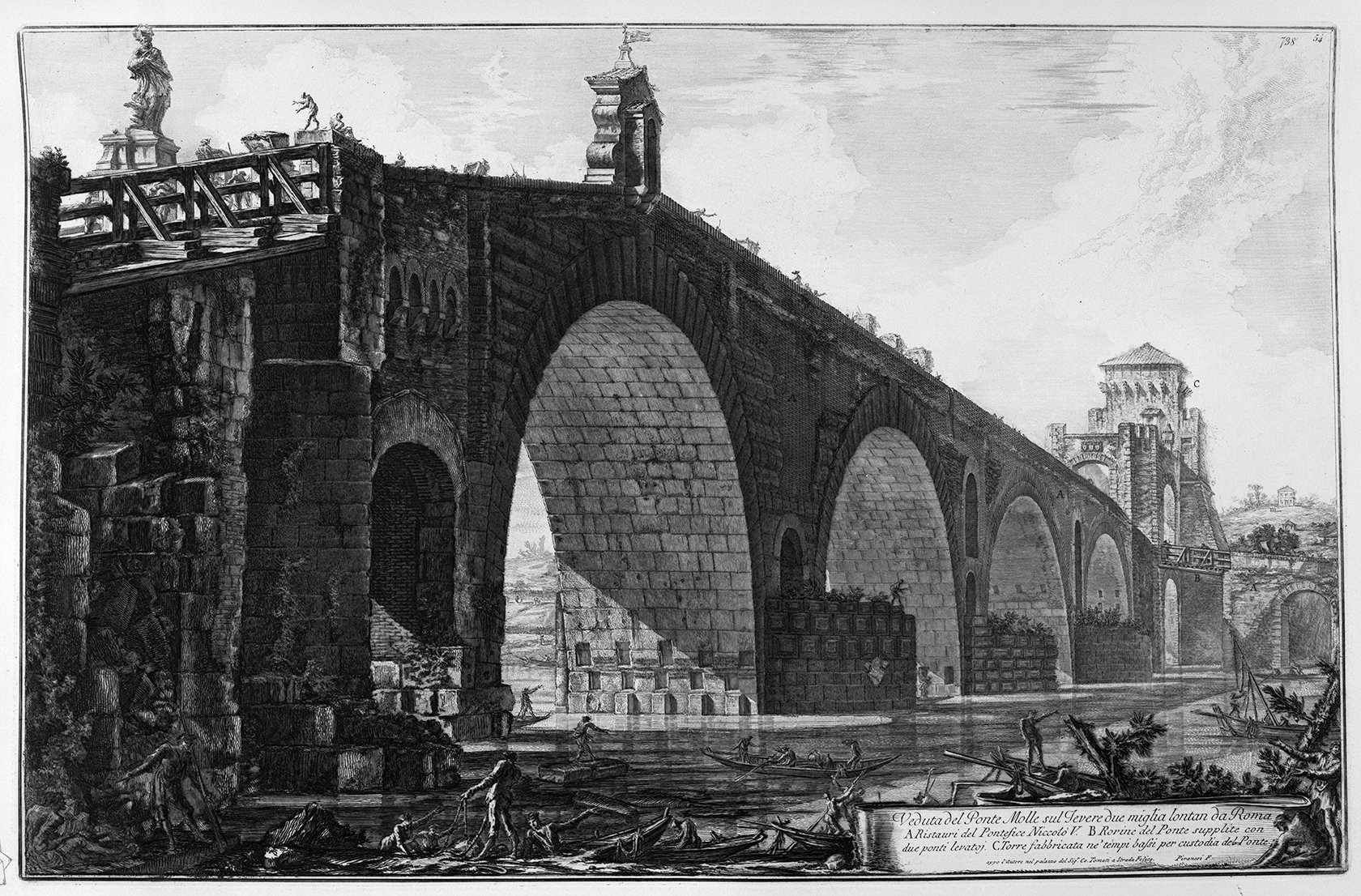
An 18th-century view of Ponte Milvio by Giovanni Battista Piranesi (credit)
Horatio at the Bridge
The first memories of Rome’s famous bridges for Lisa and Pat were long before they moved to the Eternal City. They remember their grandfather reciting from memory the epic poem “Horatio at the Bridge” by Thomas Babington Macaulay that was published in his 1842 book Lays of Ancient Rome. The narrative poem tells of when Horatio (Orazio in Italian) saved Rome from the invasion of the Etruscans by holding them off and destroying the Pons Sublicius bridge in the late 6th century BC. Pat suggests reading the majestic opening out loud, and then stopping everything while you read the whole wonderful poem.
LARS PORSENA of Clusium,
By the Nine Gods he swore
That the great house of Tarquin
Should suffer wrong no more.
By the Nine Gods he swore it,
And named a trysting-day,
And bade his messengers ride forth,
East and west and south and north,
To summon his array.
Read the full poem “Horatio at the Bridge” here.
We hope you enjoyed this look at some of the most beautiful bridges in Rome and that it inspires you to visit many of them on your next visit. Check out our Minerva’s Treasure and Elegante apartments in Rome for more options to stay near the Tiber in the heart of Rome. As you cross the Tiber and walk in the steps of so many people before you, those very bridges may just become part of some of your favorite memories of Rome, too!
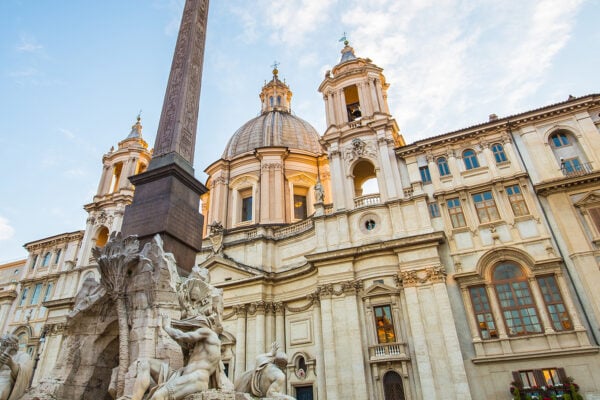
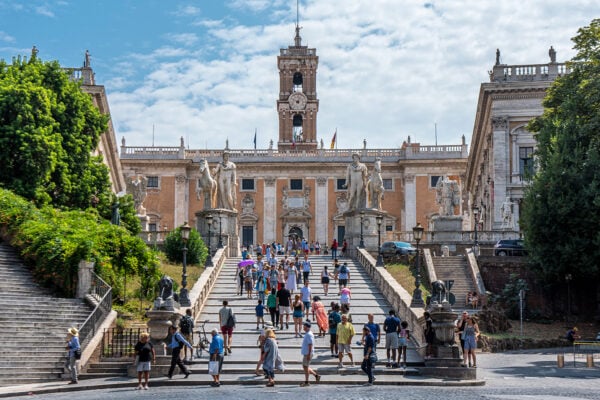
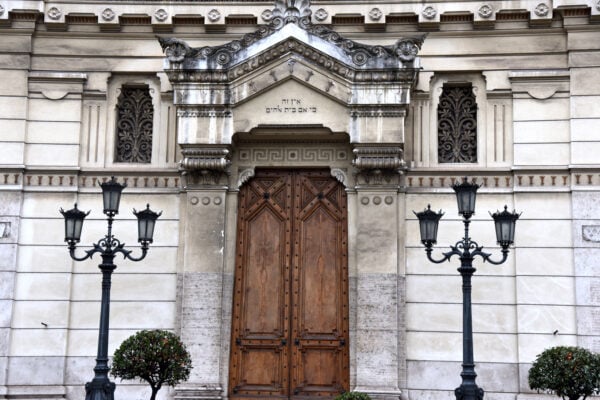
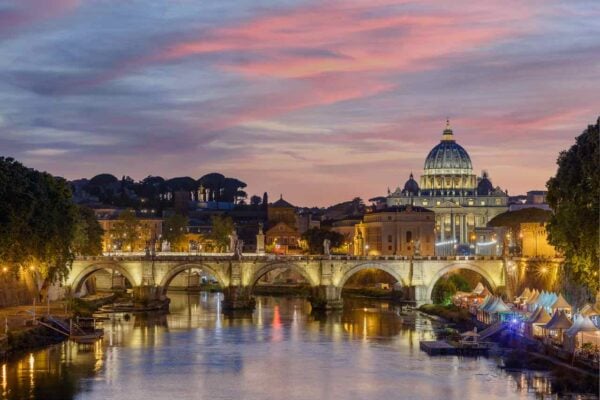
“Sun, who tarries on high, contemplating Rome:
Greater never you’ve nor shall you in future see greater
Than Rome, O sun, as your priest, Horace, enraptured foretold…”